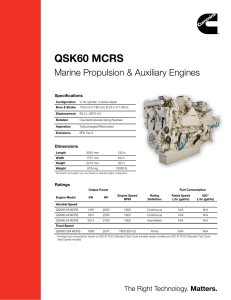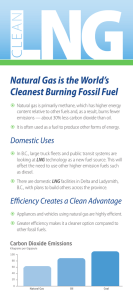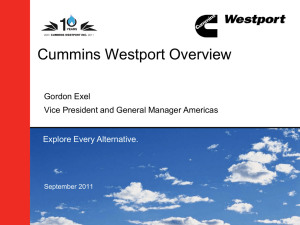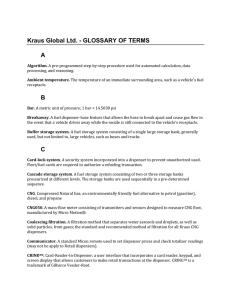ISL G Technology Overview - Greater Indiana Clean Cities Coalition
advertisement
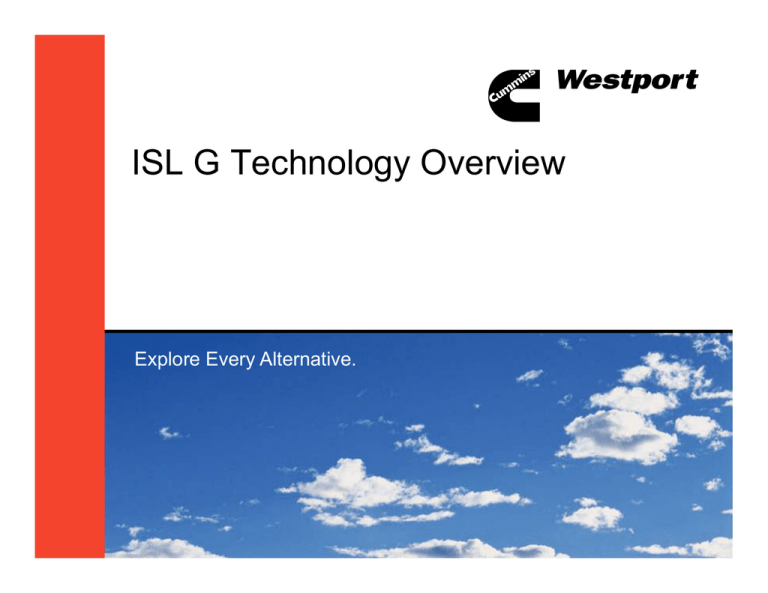
ISL G Technology Overview Explore Every Alternative. The 3 E’s: There are three key reasons for using Natural Gas to power commercial vehicles. Environmental Leadership Economic Benefits Energy Policy Simpler Cleaner Fuel Complex Hydrocarbon Simplest Hydrocarbon High hydrogen-to-carbon ratio results in GHG advantage Energy Policy: The U.S. is the world’s largest consumer of imported oil. Top 25 Petroleum Importers EIA data for year 2007 4 Large & Growing Natural Gas Opportunity Forecast: Delivered Energy Prices for Diesel & Natural Gas Transportation Fuels, 2010-2035 Gas Shale Plays are an Industry Changing Breakthrough 2008 Equivalent U.S. Dollars Per Gallon Equivalent North America Resource Estimates 2,119 Tcf of Total Resource 95+ Year Supply at 75 Bcf/d 70+ Year Supply at 100 Bcf/d Source U.S. Energy Information Administration, Annual Energy Outlook 2010 5 Energy Security 6 Lower Fuel Costs-Historically 25-40% Price difference to diesel is growing Natural gas price is lower with new supply Cummins Westport Inc. (CWI) is a Joint Venture of Westport & Cummins Westport Innovations Inc. Cummins Inc. Cummins Inc. 50/50 “CWI” Cummins Westport Inc. 8 Over 30,000 Engines Delivered June 2011 Over 10,000 ISL Gs CWI: Fully integrated within Cummins. We are Cummins’ automotive natural gas engine company. Product Engineering Manufacturing Sales Cummins Tech Center Cummins VPI Process Cummins Plants Cummins Account Teams & Distributors Warranty Cummins Warranty Parts & Service Cummins Distributors 10 Why ISL G? Environmental Leadership ISL G Met Regulated 2010 EPA/Euro EEV in 2007 20% Lower greenhouse gas emissions Economic Benefits Improved Reliability Improved Efficiency Lower total fuel costs Energy Security Reduced reliance on oil Biomethane capable 11 ISL G Natural Gas Engine 8.9 Litre (540 cu. In.) In line 6 cylinder Charge Air Cooled (CAC) Spark ignition Peak Rating: – HP-320 hp Torque -1000 lb-ft Certified to 2010 EPA and CARB NOx and PM standards Three Way Catalyst Aftertreatment Manufactured by Cummins in Cummins Engine Plant- Rocky Mount, North Carolina Over 10,000 in service 12 • 2007 - 1st Heavy Duty Engine Certified 2010 EPA • 2008 - # 1 Natural Gas Engine in Transit • 2009 - #1 Natural Gas Engine in Refuse • 2010 - #1 Natural Gas Engine in Conventional Truck 13 Cummins Westport - 30,000 Automotive Engines Delivered 10,000 ISL Gs produced in 4 Years 14 Evolution of Natural Gas Engine Technology Stoichiometric combustion is the ideal combustion process during which fuel and oxygen are burned completely – – – – Early HD natural gas engines were stoichiometric Ideal air/fuel ratio - chemically correct mixing of fuel and air Consumes all fuel & air without excess of either in exhaust Three way catalyst (TWC) aftertreatment is highly effective at NOx reduction, but only if there is no oxygen in exhaust stream Lean Burn combustion, adds air to the air fuel mixture so the air content is higher than the stoichiometric ratio – Evolution from Stoichiometric to meet market demands – Lean burn in heavy duty NG enabled better efficiency, power density and durability than conventional stoichiometric combustion – Excess air leads to reduced exhaust temperatures – Oxygen in exhaust enables oxidation catalyst, not TWC Stoichiometric combustion with cooled EGR combines & improves the best attributes of both Stoichiometric & Lean Burn combustion. – – – – Cooled EGR (CEGR) replaces the additional air in Lean Burn combustion CEGR reduces exhaust temperature similar to lean burn engines Better efficiency and power density compared to Lean Burn and Stoichiometric technologies Enables a TWC for NOx control. 15 2010 ISL G - Three Key Emission Technologies Cooled Exhaust Gas Recirculation (CEGR) Cummins Stoichiometric Combustion Cummins Westport Three Way Catalyst (TWC) Cummins Emission Solutions 16 CWI 2010 Technology O2 Sensor T Three Way Catalyst Charge Air Cooler Spark Plug Spark Ignited Combustion O2 Sensor EGR Cooler Fuel Stoich EGR Three Way Catalyst Architecture Throttle 17 Benefits of Stoichiometric EGR Combustion Increased power density – Torque curves are virtually the same as diesel – Diesel-like transient response/performance – More torque at idle (+34%) Increased thermal efficiency – 5% fuel economy improvement vs. lean-burn natural gas engines – Lower methane emissions (GHG benefit) Decreased emissions – Meets 2010 emission standards – Lower carbon (greenhouse gas) emissions – Quiet - ISL G is 9.9 decibels quieter than ISL9 at Idle/no load – Simple, passive, maintenance-free aftertreatment 18 Three Way Catalyst TWC reduces three harmful emissions: NOX, CO, HC End products are: N2, CO2, H2O Packaged as a replacement muffler Simple, passive, maintenance-free Consistent performance across all duty cycles Catalyst Inlet Catalyst Outlet NOX N2 CO CO2 HC H2O ISL G TWC -­‐ similar package size to current mufflers Tough California Emissions Standards and Cummins Westport Engines California Air Resources Board - Executive Order Shows Emissions Results ISL G is under 2010 NOx and PM regulations NMHC NOx CO PM FTP EUR O FTP EUR O FTP EUR O FTP EUR O STD 0.14 0.14 0.2 0.2 15.5 15.5 0.01 0.01 CERT 0.13 0.04 0.13 0.01 1.2 0.4 0.002 0.000 FTP: Federal Test Procedure [ transient and steady state ] EURO: Euro III European Steady-State Cycle STD: standard or emissions test cap CERT: certification level Further Reductions are Being Explored • Sub Ambient • “Zero” Emissions 20 Up to 20% Lower Greenhouse Gas Emissions As natural gas fuel economy improves, CO2 emissions are reduced CH4 emissions, adjusted to consider GHG impact are less than 10% of total GHG emissions. Well to Wheel (WTW) analysis with GHGenius modeling tool predicts over 20% WTW GHG emissions benefit for natural gas vs. diesel. Using landfill gas or anaerobic gas as a biomethane fuel increases GHG difference to ~90%. Cummins Westport approves the use of biomethane that meets fuel specifications. Source: Presentation to AFVI convention by Don O’Conner (S&T)2 Consultants May 2008 21 GHG - Biomethane Fuel Impact 2012 Results (California) Biogas based fuel improves GHG reduction by 75-200% Source:http://www.nsca.org.uk/assets/ biogas_ as_transport_fuel_june06.pdf Natural Gas Vehicle has 20 - 22% Lower GHG with fossil gas Source: CEC-600-2007-004-REV GHG emissions per kWh on the shaft Well-to-Wheel Greenhouse Gas Emissions 800 732 700 600 500 400 300 240 200 66 100 26 11 0 Diesel, crude oil Ethanol, wheat Ethanol, enzyme wood Ethanol, wood via black liquor Biogas as CNG/LNG CO2 equivalent / any greenhouse gas converted into same greenhouse effect as CO2 Source: Volvo Group – transit 23 How Big is a Ton of CO2? One CNG Transit bus reduces CO2 by approx 97.6 trailers full per year. Reduced Noise Communities notice the natural gas noise advantage. ONE Diesel engine idling is louder than TEN natural gas engines idling together ISL G is 5.5 decibels quieter at peak torque and load ISL G is 9.9 decibels quieter at Idle/no load Technology What is the Same? 320, 300, 280, 260 and 250 HP ratings – Block, crankshaft, main bearing, piston rods, EGR Compatible with Cummins Diagnostic tools – Over 80% parts commonality Major Engine Components 500 hour Maintenance Interval Parts and Service – Global Cummins Distributor Network – Insite – Quickserve online Manufactured in Cummins Engine Plant, North Carolina 26 ISL G Warranty - Every Coverage 27 Technology What is Different? Cylinder head – 2 valve vs. 4 valve (diesel) Ignition – Spark Ignition (SI) vs. Compression (diesel) Fuel System – Intake manifold vs. Common rail injection (diesel) Aftertreatment – 3 way catalyst vs. Particulate Filter + Selective Catalytic Reduction (diesel) Lubricating Oil – Natural gas engines require a specific oil that meets Cummins specification CES 20074 Noise – Natural gas engines are up to 10db quieter at idle Compression Ratio – ISL G is 12:1 compression Maintenance Cost – Incremental cost of maintenance related to ignition and overhead valve adjustments adds up to $0.03 per mile ($0.02 per km) to ISL G 28 ISL G Components EGR Valve Fuel Module ECM ICM EGR Cooler Wastegate Turbo Crankcase Breather EGR Crossover Tube 2 Valve Cylinder Head & Coil on Plug Ignition Initial valve set at 1,000 hours, 2,000 hours thereafter Ignition coils mounted at 45 degree angle One coil per cylinder, left side of valve cover Spark Plug change interval is 1,500 hours Turbocharger, Exhaust Manifold, EGR Cooler EGR Crossover Tube Wastegated Turbocharger Three Way Catalyst Aftertreatment Similar to catalyst on gasoline passenger cars Packaged as a muffler. Vertical or horizontal mount Weighs ~100 pounds Passive device Benefits: – Maintenance-free – Reliable – No regeneration events – Easy to install in vehicle 32 2010 Engines Aftertreatment Comparison SCR Catalyst Heated DEFTank Particulate Filter DEF Dosing Control Unit ECM Cummins TWC 33 Estimated System Weight ~ 60 Gallons Fuel CNG – 1,000 lbs more LNG – 300 lbs more System Weights ISL9 Diesel ISL G Natural Gas Engine 1,695 lbs 1,625 lbs 450 lbs 100 lbs Aftertreatment Fuel Tanks - Diesel (60 Gal) 100 lbs (550 lbs Full) - CNG (60 DGE) 1,600 lbs (2,000 lbs Full) - LNG (68 DGE) 815 lbs Total Weight (Full) 2,695 lbs (1,288 lbs Full) CNG - 3,725 lb LNG - 3,013 lb 34 Keys to Success Follow Cummins maintenance intervals and procedures outlined in Operation and Maintenance manuals Use Cummins Authorized parts Set oil drain / service intervals based on average fleet speed Default interval is the hours stated. – Interval is Defined by application and average speed – hours, miles or time, which ever comes first Example: Normal Duty - Oil Drain/Service Intervals Average Vehicle Speed Kilometers Miles Hours Months Normal Duty -Truck 24,000 15,000 500 6 Transit Bus 10-15 mph 9,650 6,000 500 6 Refuse Truck 10-15 mph 9,650 6,000 500 6 Use only natural gas engine oil (CES 200074) Check air intake every 250 hours, and use only OEM approved air filters Perform Initial Overhead Valve adjustment at 1,000 hours or 15,000 miles (24,000 km) Use 15W-40 Natural Gas Engine Oil Cummins Westport natural gas engines require special engine oil that is available from major oil suppliers. Careful attention must be paid to engine oil specifications because natural gas engine oil has different properties than diesel engine oil. A sulfated ash limit of 0.6 percent has been placed on all engine lubricating oil recommended for use in Cummins Westport engines. Higher ash oils can cause valve and/or piston damage and lead to excessive oil consumption and degradation of the catalyst. Do not use diesel engine oil in a natural gas engine. If diesel engine oil is used, valve torching, piston scuffing, and reduction in spark plug life will occur. 36 CES20074 Gas Engine Only (GEO) engine oil is available from most major oil companies 37 ISL G Ratings ADVERTISED HP ENGINE MODEL (KW) @ RPM PEAK TORQUE LB-FT @ RPM GOVERNED SPEED ISL G 320 320 (239) @ 2000 1000 (1356) @ 1300 2200 RPM ISL G 300 300 (224) @ 2100 860 (1166) @ 1300 2200 RPM ISL G 280 280 (209) @ 2000 900 (1220) @ 1300 2200 RPM ISL G 260 260 (194) @ 2200 660 (895) @ 1300 2200 RPM ISL G 250 250 (186) @ 2200 730 (990) @ 1300 2200 RPM 38 Fuel Natural gas fuel must meet ISL G fuel specs per AEB 79.05 Minimum Methane Number (MN) is 75 Natural Gas fuel for the ISL G can be stored on the vehicle in either liquid (LNG) or compressed (CNG) form. ISL G requires fuel to be regulated to max 150 psi, min 70 psi Cummins Westport approves the use of up to 100% biomethane that meets Cummins published natural gas fuel specifications 39 CNG Delivery Chain Source Producer Conventional Unconventional - Shale Renewable - BioMethane Compress CNG Fuel Station 40 CNG Fuel Stations CNG Fast Fill Station Rapid succession vehicle fueling Large compressor(s) Three or more storage vessels Fast Fill CNG Dispenser CNG Time Fill Station Overnight fueling Small compressor One storage vessel Dual hose or single hose posts CNG Time Fill 41 LNG Delivery Chain Source Producer Conventional Unconventional - Shale Renewable - BioMethane Liquefy Transport LNG Fuel Station 42 LNG Fuel Stations LNG is trucked to refueling station in 10,000 gallon tanker trailers – LNG source is typically a dedicated liquefaction plant for vehicle LNG or utility company LNG peak-shaving plant – “Small-scale” liquefaction (i.e. smaller than industrial-scale liquefaction plants) is expected to increase LNG availability Requires on site LNG bulk storage tank, typically 13,000 to 16,000 gallons LNG dispensed to vehicle tanks as a cryogenic liquid – Approx 50 gpm refueling rate LNG stations cost less than CNG stations – Easier to pump a liquid than compress a gas 43 Recent market activity points to “corridors” that support the on highway market for natural gas. Step 1: Serve Local/ Regional Trucking Hubs Step 2: Serve Lanes that Connect the Hubs Note: Chesapeake $1 billion investment announcement (July 2011) 44 OEM Supplied Fuel System Components (Both CNG and LNG Systems) Mounted on the vehicle Regulates storage pressure down to engine specification pressure (70-150 psi) Note drain on pre-filter has a drain requirement Must be drained if there is 1 oz of liquid CNG Fuel Storage Strong and safe - Carbon fiber wrapped CNG tanks – 3,600 psi capability Can be mounted vertically or horizontally Each tank carries approx.15 diesel equivalent gallons (DGE) Shut off valve Fuel fill connection Fuel pressure gauges LNG Fuel System LNG Economizer 75 Diesel Gallon Equivalent Tank • LNG tanks are designed with thermal properties to store natural gas as a liquid (-260 F). • The liquid leaves the tank to an economizer supplied with engine coolant to warm the gas to gaseous form. As it returns to gaseous state it expands and pressurizes the system. • A LNG fuel system is a low pressure system designed for normal operating pressure of 230 psi. Established ISL G Applications BUS REFUSE CWI is available from leading urban bus and cab over refuse truck companies Transit ISL G Availability OEM New Flyer NABI Orion ElDorado MCI Model 30/35/40 Low Floor 35/40 Low Floor Orion V HF EZ Rider II Motor Coach 60 BRT Orion VII LF Fuel CNG CNG CNG LNG/CNG 40 and 45 ft Engine ISLG 280 ISLG 280 ISL G 280 ISLG 280 ISLG 320 ISL G 320 Top North American CNG Transit Fleets LAMTA, Los Angeles, CA OCTA, Orange County, CA Big Blue Bus, Santa Monica, CA TransLink, Vancouver, BC NY / Long Island Transit, NY San Diego Transit, CA Foothills Transit, San Gabriel Valley, CA RTC Transit, Las Vegas, NV HSR, Hamilton, ONT Fort Worth, TX Santa Clara, CA Tacoma, WA St. Louis, MO Cab Over Refuse Truck Availability OEM AutoCar Mack Peterbilt American Lafrance Crane Carrier Model Xpeditor TerraPro LE 320 Condor LET Terra Pro CO Fuel LNG/CNG LNG/CNG LNG/CNG LNG/CNG LNG/CNG Engine ISLG 320 ISLG 320 ISL G 320 ISL G 320 ISLG 320 . North America Refuse Fleets OR City of Los Angeles, CA City of Toronto Miller Waste, Ont Republic Service City of Sacramento, CA EMI, Que Specialty Solid Waste Long Island, NY City of Surrey, BC City of New York Smithtown, NY Denver, CO Waste Management (USA & Canada) Conventional Truck Availability OEM Freightliner Peterbilt Kenworth Volvo Model M2 – 112 320 T800SH VNM SD - 114 384 W900S 365 T440 T470 Engine ISLG 320 ISL G 320 ISLG 320 ISL G 320 6x4 Tractor Tractor Tractor Tractor 4x2 Tractor Vocational Vocational 4x2 Truck Mixer Mixer ISL G 300 Application 6x2 Truck Vocational OR 51 Automotive Natural Gas Truck Market Cummins Westport Confidential 52 Other OEMs OEM Thomas Capacity Autocar Blue Bird Application School Bus Yard Tractor Yard Tractor Model Type D Capacity – TJ9000 Autocar - Xspotter Engine ISLG 250 ISL G 250 ISLG 320 OR 53 CWI Contact Information Bill Boyce, Eastern USA – bill.boyce@cummins.com – Office: (330) 534-8352 – Cell: (330) 720-9785 Jerry Johnson, Western USA – jerry.j.johnson@cummins.com – Cell: (303) 396-9821 Jeff Campbell, Canada – jeff.campbell@cummins.com – Office: (604) 718-2099 – Cell: (604) 318-4790 Gordon Exel, VP & General Manager, Americas – gordon.exel@cummin.com – Office: (604) 718-8384 – Cell: (604) 764-9867 Gloria Stewart, Account Executive gloria.stewart@cummins.com Office: (812)-377-0481 Cell: (812)-350-2684 Brandon Davis, Technical Support Manager – brandon.c.davis@cummins.com – Office: (562) 760-4537 – Cell: (562) 760-4537 www.cumminswestport.com 55

